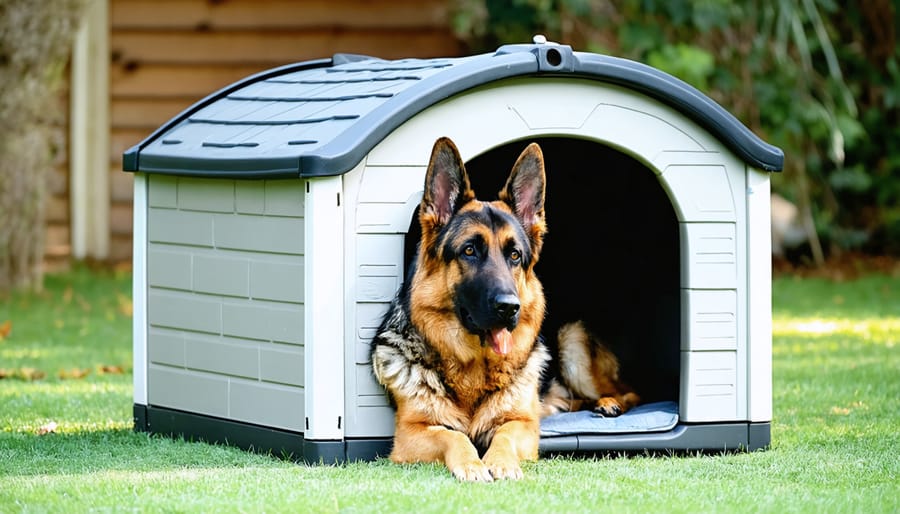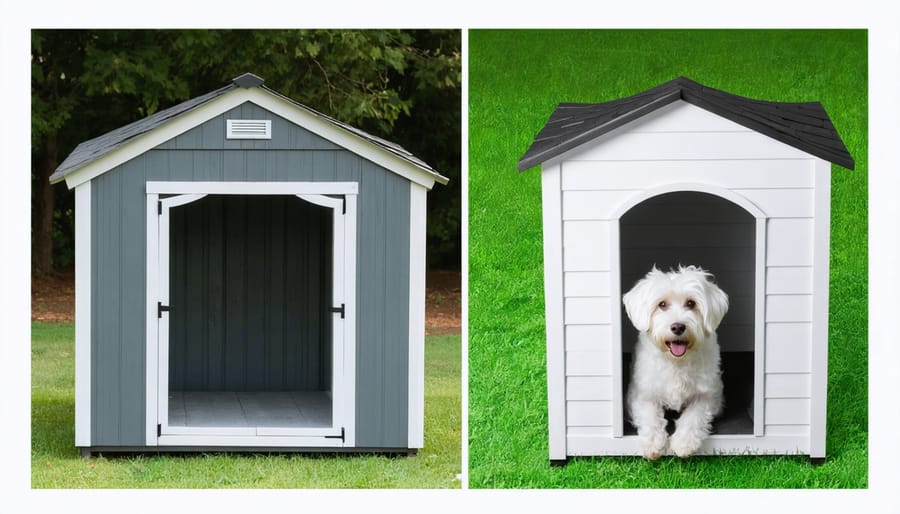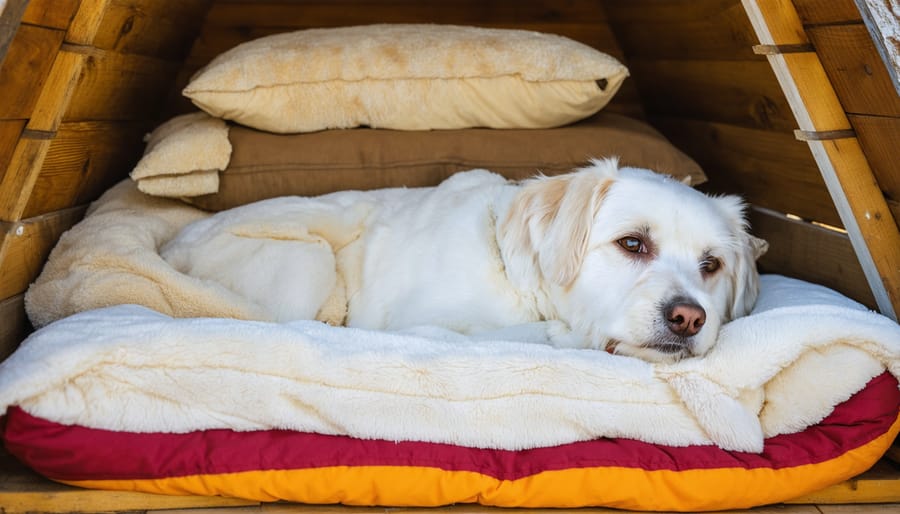Creating a safe and comfortable outdoor living space for your German Shepherd demands careful consideration of their unique needs and natural instincts. These intelligent, active dogs require housing solutions that protect them from harsh weather while providing enough space to move freely and maintain their territorial instincts. A well-designed German Shepherd shelter must accommodate their large size – typically 22-26 inches at the shoulder – while offering proper ventilation, insulation, and security features.
Whether converting an existing shed, installing a custom doghouse, or modifying your garage space, the housing structure should include elevated flooring to prevent moisture buildup, weather-resistant materials, and sufficient space for your shepherd to stand, turn around, and lie down comfortably. The ideal shelter dimensions should measure at least 4 feet wide by 6 feet long, with a minimum height of 4 feet to accommodate their natural posture and movement patterns.
Beyond basic shelter requirements, your German Shepherd’s housing should include separate zones for sleeping, eating, and exercise, protecting them from extreme temperatures while allowing them to maintain their instinctive guard dog behaviors. Consider incorporating features like covered porches for outdoor observation and secure fencing to create a safe, contained environment that satisfies both their physical needs and working dog mentality.
Why German Shepherds Need Their Own Space
Size and Space Requirements
German Shepherds need ample space to feel comfortable and secure in their housing. For an outdoor dog house, plan for dimensions of at least 4 feet wide by 4 feet deep by 3 feet high. This allows your dog to stand up, turn around, and lie down comfortably. The entrance should be about 2 feet wide and 2.5 feet high, positioned slightly off-center to protect against direct wind and rain.
When converting existing structures like sheds or garages, allocate at least 60 square feet of living space for your German Shepherd. This gives them room to move around and includes space for their bed, food and water bowls, and toys. Remember to factor in additional space for proper ventilation systems and insulation.
For indoor spaces, ensure doorways and passages are wide enough (minimum 3 feet) to accommodate your dog’s size comfortably. If creating a dedicated indoor area, consider including a cozy corner with their bed and personal items. German Shepherds are active dogs, so additional space for play and exercise near their housing is essential, ideally with access to a fenced yard or run area of at least 200 square feet.

Weather Protection Needs
German Shepherds are hardy dogs, but they still need proper protection from extreme weather conditions when housed outdoors. Their double coat provides natural insulation, but additional weather protection is essential for their comfort and well-being.
In hot weather, ensure the housing structure offers adequate shade and ventilation. Consider installing mesh windows or vents near the roof to allow hot air to escape. The roof should extend beyond the walls to create shaded areas and prevent rain from entering. Light-colored materials reflect sunlight better, helping maintain cooler temperatures inside.
For cold weather, the housing needs to be draft-free while maintaining some ventilation. Install weather stripping around doors and windows, and consider adding insulation to walls and roofing. The entrance should face away from prevailing winds, and a door flap can help retain warmth while allowing easy access.
Elevation is crucial year-round – the house should sit several inches off the ground to prevent moisture seepage and maintain better temperature control. During rainy seasons, proper drainage around the structure will prevent water accumulation and keep the living area dry.
Converting Storage Sheds into Dog Houses

Choosing the Right Shed Material
When converting a shed into a comfortable space for your German Shepherd, the material choice significantly impacts durability, maintenance, and comfort. After ensuring proper site preparation, consider these popular options:
Metal sheds offer excellent durability and weather resistance at a budget-friendly price point. They’re particularly suitable for warmer climates and require minimal maintenance. However, they can become quite hot in summer and cold in winter, necessitating additional insulation.
Wooden sheds provide natural insulation and are aesthetically pleasing, making them a popular choice among homeowners. They’re easily customizable and can be modified to include ventilation windows or dog doors. Regular maintenance, including sealing and checking for moisture damage, is essential to prevent rot and extend longevity.
Modern vinyl storage options offer the best of both worlds. They’re virtually maintenance-free, naturally resistant to moisture and pests, and provide better temperature regulation than metal. While initially more expensive, their durability and low maintenance requirements make them cost-effective in the long run.
For German Shepherds specifically, wooden or vinyl materials often prove most suitable, as they’re easier to insulate and modify. When choosing, consider your local climate, budget, and willingness to perform regular maintenance.
Essential Modifications
Creating a comfortable living space for your German Shepherd requires several essential modifications to ensure proper ventilation, insulation, and overall comfort. Start by installing ventilation windows to maintain good airflow, which is crucial for preventing moisture buildup and keeping your dog comfortable in varying temperatures. Position these windows strategically to create cross-ventilation while avoiding direct drafts on your pet’s sleeping area.
For insulation, focus on both the walls and flooring. Add weather-resistant insulation panels to the walls, ensuring they’re properly sealed to prevent moisture penetration. The floor should be raised at least 4 inches off the ground to prevent cold and dampness from seeping up. Install plywood flooring over pressure-treated supports, then add rubber matting or specialized kennel flooring for comfort and easy cleaning.
Consider adding these comfort features to make the space more welcoming:
– A cozy sleeping platform with washable bedding
– Built-in food and water bowl stations
– Storage areas for toys and supplies
– Motion-activated lighting for nighttime visibility
– A covered entryway to protect from rain and wind
Temperature control is essential for year-round comfort. Install a small, pet-safe heating system for winter months and consider adding a battery-operated fan for summer cooling. Make sure all electrical components are safely enclosed and out of your dog’s reach.
Don’t forget about drainage – slope the surrounding ground away from the structure and install gutters to direct rainwater away from the entrance. This prevents water from pooling around the housing area and keeps the interior dry during wet weather.
These modifications not only ensure your German Shepherd’s comfort but also make the space more functional for you as an owner, with easier maintenance and better accessibility for cleaning and care routines.
Comfort and Safety Features
Bedding and Interior Setup
Creating a cozy interior for your German Shepherd’s housing is crucial for their comfort and well-being. Start with a raised platform or bed base to keep the sleeping area off the ground, preventing dampness and providing insulation. Cedar shavings or straw make excellent base materials, as they’re naturally insect-repellent and help maintain proper ventilation for pet housing.
Layer the bedding with washable, chew-resistant materials like orthopedic dog beds or heavy-duty foam pads. During colder months, add thermal blankets or specialized dog bedding designed for outdoor use. Remember to position the sleeping area away from any drafts while maintaining good airflow throughout the space.
Consider installing removable panels or dividers to create distinct areas for sleeping, eating, and playing. This helps keep the space organized and makes cleaning easier. Add non-slip mats near feeding areas to prevent spills and maintain cleanliness.
For comfort during extreme weather, consider installing thermal insulation in the walls and roof. Reflective barriers or foam insulation boards work well when properly sealed. Place weather stripping around doors and windows to prevent drafts while maintaining temperature control.
Remember to regularly inspect and clean bedding materials, replacing them when they show signs of wear or damage. This helps maintain a healthy environment for your German Shepherd while extending the life of their housing setup.

Security and Access Features
Securing your German Shepherd’s housing is essential for both safety and peace of mind. Start with a sturdy door that your dog can’t push through, ideally featuring a heavy-duty latch or lock system that’s easy for humans to operate but impossible for dogs to manipulate. Many owners opt for double-door systems, with one inner door for ventilation and an outer solid door for protection against harsh weather.
Install locks at both the top and bottom of the door to prevent your clever shepherd from figuring out how to escape. Choose weather-resistant padlocks or sliding bolt locks that won’t rust or jam over time. If your housing has windows, ensure they’re properly secured with strong mesh or grilles that allow ventilation while preventing escape attempts.
Consider installing motion-sensor lights around the housing area for added security during nighttime. This not only helps you monitor your pet but also deters potential intruders. Some owners add security cameras connected to their smartphones for real-time monitoring of their dogs.
For areas with wildlife concerns, reinforce the bottom edges of the housing with buried wire mesh to prevent digging from both inside and outside. Create a secure fenced area around the housing unit, extending at least six feet high with no gaps or weak points that could tempt your agile shepherd to attempt an escape.
Remember to regularly inspect all security features, tightening loose hardware and replacing any worn components promptly.
Maintenance and Care
Regular Cleaning Schedule
Maintaining a clean living space for your German Shepherd is essential for their health and comfort. Create a daily routine of removing waste from their designated area, especially if they spend significant time in their outdoor housing. This simple task prevents odors and keeps the space hygienic.
Weekly cleaning should include thoroughly sweeping or vacuuming the housing area, washing food and water bowls with mild soap, and wiping down walls and surfaces with pet-safe cleaners. Pay special attention to corners and crevices where dirt can accumulate.
Monthly deep cleaning is crucial for long-term maintenance. Remove all bedding and wash it in hot water, sanitize the entire space with pet-friendly disinfectant, and check for any signs of pest infestation. During warmer months, consider hosing down outdoor housing areas to remove built-up dirt and debris.
Replace bedding every 3-4 months or sooner if it shows signs of wear. Keep cleaning supplies organized in a nearby storage container for easy access. Consider using washable bed covers that can be easily removed and cleaned between full bedding replacements.
During seasonal changes, conduct thorough inspections and cleaning of ventilation areas, checking for any damage that might have occurred. This is also a good time to assess whether additional weather protection is needed for the upcoming season.
Remember, a clean living space contributes significantly to your German Shepherd’s overall wellbeing and helps prevent health issues before they arise.
Seasonal Maintenance Tips
German Shepherds need different housing accommodations throughout the year to stay comfortable and healthy. During summer months, ensure proper ventilation by adding mesh windows or installing a cooling fan. Create shaded areas around the housing structure using outdoor curtains or extending the roof overhang to protect from intense sunlight. Consider placing cooling mats inside the shelter for extra comfort during hot days.
As winter approaches, add weather stripping around doors and windows to prevent drafts. Install removable insulation panels on walls and raise the sleeping area off the ground with a platform bed. Use straw or cedar shavings for bedding, replacing them regularly to maintain cleanliness and warmth. Consider adding a self-warming pet pad for extremely cold nights.
During rainy seasons, check that the roof is completely waterproof and ensure proper drainage around the structure to prevent flooding. Add a covered entrance area to keep the interior dry when your dog enters and exits. Consider installing rubber mats at the entrance to minimize mud tracking.
For spring, deep clean the entire structure and check for any winter damage. Remove winter insulation panels to improve airflow and inspect for signs of pest infestation. This is also the perfect time to repair any loose boards or damaged areas before summer arrives.
Remember to adjust these modifications gradually as seasons change, allowing your German Shepherd time to adapt to their updated living space.
Creating a comfortable and secure home for your German Shepherd doesn’t have to be complicated or overwhelming. Whether you’ve chosen to convert an existing shed, build a custom doghouse, or modify your garage space, the key is to prioritize your dog’s comfort, safety, and natural behavioral needs.
Remember that German Shepherds are active, intelligent dogs who need adequate space to move around, protection from the elements, and proper ventilation. The housing solution you choose should reflect these requirements while fitting seamlessly into your property’s layout and your lifestyle.
Take time to properly insulate and weatherproof your chosen structure, install appropriate flooring, and ensure good air circulation. Regular maintenance and cleaning will help extend the life of your dog’s home while keeping it healthy and inviting.
Don’t forget to personalize the space with comfort items like bedding, toys, and water stations. Your German Shepherd will appreciate having their own designated area that feels safe and welcoming. Consider adding features that make the space more engaging, such as windows or a covered outdoor area for supervised outdoor time.
By following the guidelines and safety considerations we’ve discussed, you’ll create a housing solution that keeps your German Shepherd happy, healthy, and protected. Start planning your project today, and give your loyal companion the comfortable home they deserve.





Leave a Reply